Honda 250r 2015
![CR2502015YUCCA]() Q: FIRST AND FOREMOST, IS THE 2015 HONDA CRF250 BETTER THAN THE 2014 CRF250?
Q: FIRST AND FOREMOST, IS THE 2015 HONDA CRF250 BETTER THAN THE 2014 CRF250?
A: Yes, which is good news for the bike that had the distinction of finishing last in the 2014 and out of the top three in the 2015 MXA 250 Four-Stroke Shootout.
Q: HOW MANY CHANGES DID HONDA MAKE TO THE 2015 CRF250?
A: A total of eight general updates were made to the 2015 CRF250.
(1) Engine Mode Select. Unique to Honda is the Engine Mode Select button, which allows the rider to easily choose between three different ignition maps via a handlebar-mounted button. Total remapping is still possible with Honda's accessory tuning tool (PGM-FI setting tool, $620.00). The new maps can then be programmed into the Engine Mode Select button.
(2) Forks. The 2015 CRF250 receives Showa's new 49mm Triple Air Chamber (TAC) Separate Function Forks (SFF). The forks are anywhere from 2 to 2-1/2 pounds lighter than conventional dual-spring forks. The left fork leg houses the TAC (inner, outer and balance chambers), while the right leg contains the rebound and compression damping. The CRF250 fork is a slightly different design from what's found on the Kawasaki KX450F and Suzuki RM-Z450.
(3) Exhaust. A larger-diameter exhaust system and new fuel-mapping settings for the Dual-Timing PGM-FI fuel-injection system increase engine performance for smoother acceleration, improved throttle response, quicker rev and more peak power.
(4) Shock. Honda's Pro-Link rear shock is equipped with the same 5.3 kg/mm spring as last year, but the valving is firmer.
(5) Front brake. The CRF250 retains the same master cylinder and piston size, but the front brake rotor has been upsized to 260mm.
(6) Tires. Dunlop's new Geomax MX52 tires were chosen because they work across a wide range of terrain.
(7) Throttle. Honda installed a softer throttle return spring to make the throttle easier to turn.
(8) Styling. There are bold new graphics and restyled fork guards. Additionally, the front brake guard and radiator louvers are black.
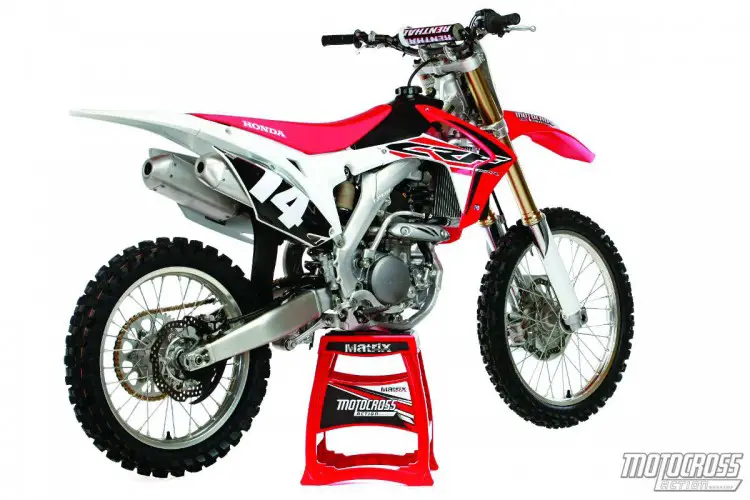
favorite, but twice pipes do look cool.
Q: WHAT IS THE MOST NOTICEABLE CHANGE TO THE 2015 HONDA CRF250?
A: Showa's 49mm air fork is the key revision on the 2015 Honda CRF250. Let us explain why.
(1) Uniqueness. Although the Showa SFF TAC comes standard on the 2015 Suzuki RM-Z450 and Kawasaki KX450F, the CRF250 version is different. The CRF250 balance chamber is inside the fork leg rather than in a piggyback chamber on the lower fork lug. Honda wanted the balance chamber inside the fork so that it would be kept out of harm's way in case of an impact.
(2) Left vs. right. The left fork leg on the CRF250 contains the air system rather than the right leg (as on the Suzuki and Kawasaki). Why? Honda believes that the lighter air leg helps the front end achieve better side-to-side balance when mated with the heavier brake on the left side.
(3) Outer chamber. Obviously, the Triple Air Chamber (TAC) fork has three air chambers. Yet, unlike the RM-Z450's and KX450F's Showa SFF TAC forks, there are only two Schrader valves on the CRF250's left fork cap. The inner chamber's Schrader valve is there, but the outer chamber orifice is plugged up. Honda's version of the SFF TAC fork doesn't allow for outer chamber pressure adjustments. Honda recommends that the outer chamber be left untouched; however, it is possible to change the outer chamber pressure if you install an additional Schrader valve.

(4) Balance chamber. The balance chamber's Schrader valve is located under the left fork leg where the rebound clicker would normally be. It is accessible by removing a black plastic cover (although it helps to remove the disc guard also). In testing, we quickly discovered that having the balance chamber's Schrader valve under the fork lug was a mistake. It's a hassle to remove the balance chamber cap, especially when it becomes packed with mud.
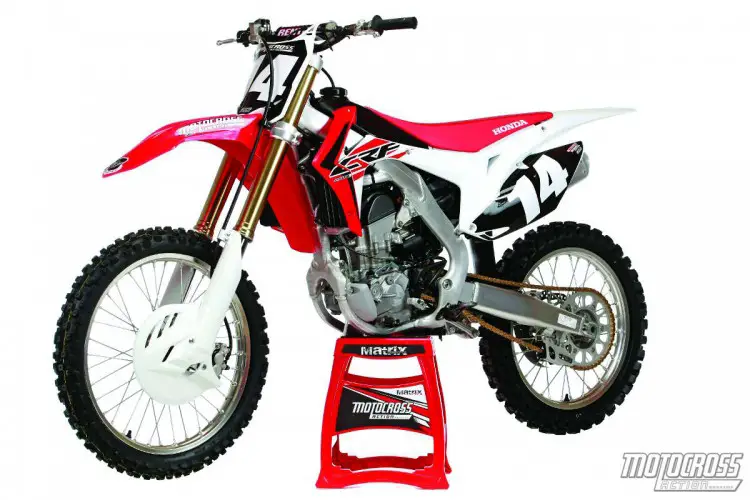
Q: WHAT DIRECTION IS HONDA TAKING WITH THE CRF250?
A: As puzzling as it may seem, Honda has embraced the mantra that "slow and steady wins the race." That strategy might work for a tortoise against a cocky rabbit, but not in a sport where horsepower is king. Need proof? The CRF250 gives up around four ponies to the Kawasaki KX250F, Yamaha YZ250F, KTM 250SXF and Husqvarna FC250. That only leaves the Suzuki RM-Z250, which hasn't received any major engine updates in several years. Simply put, it's hard to win the 100-yard dash with asthma.
In our heart of hearts, we don't feel good about bullying Big Red over its powerband choice. It is, however, our duty to point out the good and the bad. This is not a remarkable machine, but it is a decent motorcycle that is capable of winning in the hands of a certain type of rider. Now you might think that we are talking about a highly skilled AMA Pro. We aren't. This bike is best suited to Beginners and Novices—and there's nothing wrong with that. Honda's engineers know as well as the MXA wrecking crew that they could build a powerful engine if given the go-ahead. But, the powers that be don't want to do that—made obvious by the fact that the 2015 Honda CRF250 makes the same horsepower as a 2009 CRF250.
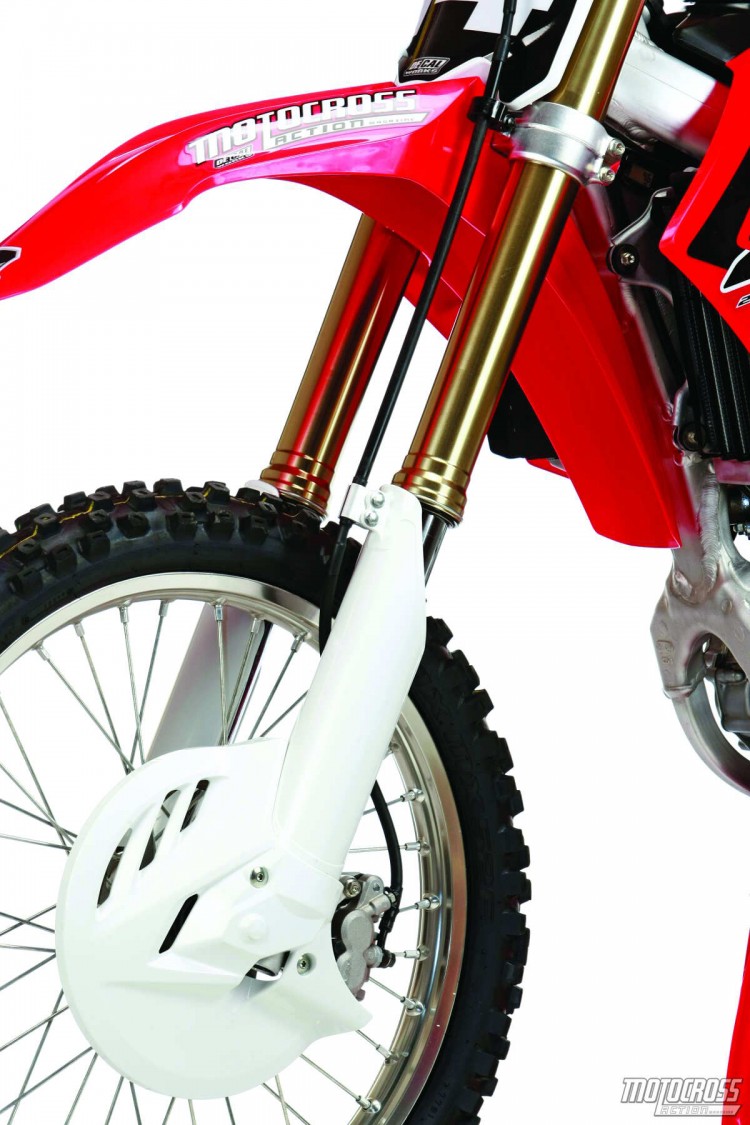
Q: WHAT DO WE THINK OF HONDA'S DUAL MUFFLERS?
A: It doesn't take a degree in engineering to understand that the CRF250's dual design is overkill. In fact, it adds very little to the overall performance of the engine while adding a considerable amount of heft. Honda's focus on attaining the perfect symbiotic relationship between weight and balance is a double-edged sword. Honda is caught up in the purity of the idea, not the reality. It is obvious to every MXA test rider that adding more weight in an attempt to balance out the side-to-side weight does no one any favors.
Are we being too critical of the twice-pipe idea? Here are the reasons we don't like two mufflers.
(1) Weight. At around 10 pounds, the CRF250 dual mufflers are heavy. There are aftermarket single CRF250 exhaust systems on the market that are upwards of 4 pounds lighter. That's a big difference.
(2) Performance. Honda should have learned the error of its ways after going with dual pipes on the 2006 to 2009 CRF250s and then abandoning them. Honda says they are an advantage; we don't agree. Single pipes are lighter, cheaper to repack, less complicated, create a narrower bike and produce more horsepower.
(3) Damage. Twice the mufflers means twice the odds of damaging the exhaust.
(4) Cost. Aftermarket twin exhaust pipes cost as much as $500 more than a single-sided CRF250 exhaust. Just go single.
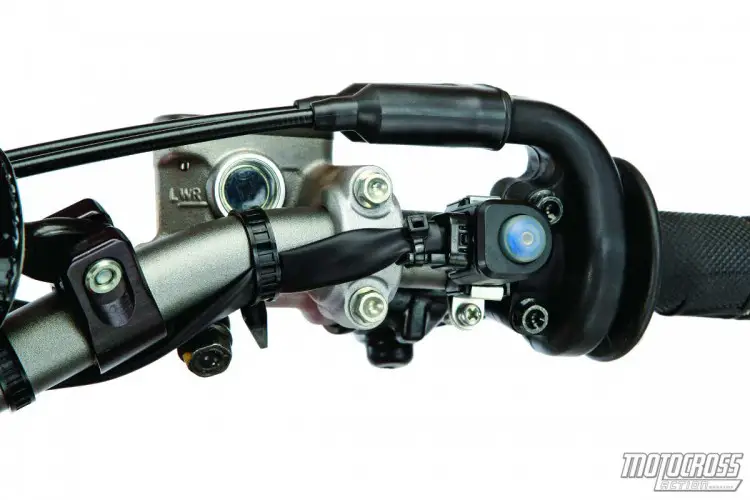
Q: HOW WELL DOES HONDA'S ENGINE MODE SELECT SYSTEM WORK?
A: It works quite well. Before explaining how well the Engine Mode Select (EMS) button performs, we should discuss its function.
Modes. The EMS button is located on the handlebars next to the front brake master cylinder. Depressing the EMS for one second switches the ignition curve to the hard-terrain (mellow) mode. This is distinguishable by two consecutive blinking lights that repeat three times. Holding the EMS button down for an additional second switches the ignition curve to the soft terrain (aggressive) map, indicated by three lights blinking consecutively and repeating three times. Holding down the button for another second will switch the mode back to stock (and a single blue light will flash).
Operation. Cycling through the map settings takes a few seconds; however, to select a map quicker, such as when going from the stock map to the aggressive map, you can triiger through the buttons, two second each, to get all the way through the cycle . It's a handy trick for those who are impatient. Setting the EMS button must be done while the engine is on. Honda's lawyers state that the bike should be idling, but our uber-talented test riders managed to switch maps while in motion (with the throttle rolled off). Having said that, we strongly advise against the idea, as it's a dangerous maneuver.
Resetting. It's important to note that the EMS does not need to be reset every time the CRF250 is restarted. If you turned it off in the aggressive map, it will start up in the aggressive map. Unfortunately, there is no indicator light that flashes upon startup to show which map is selected.
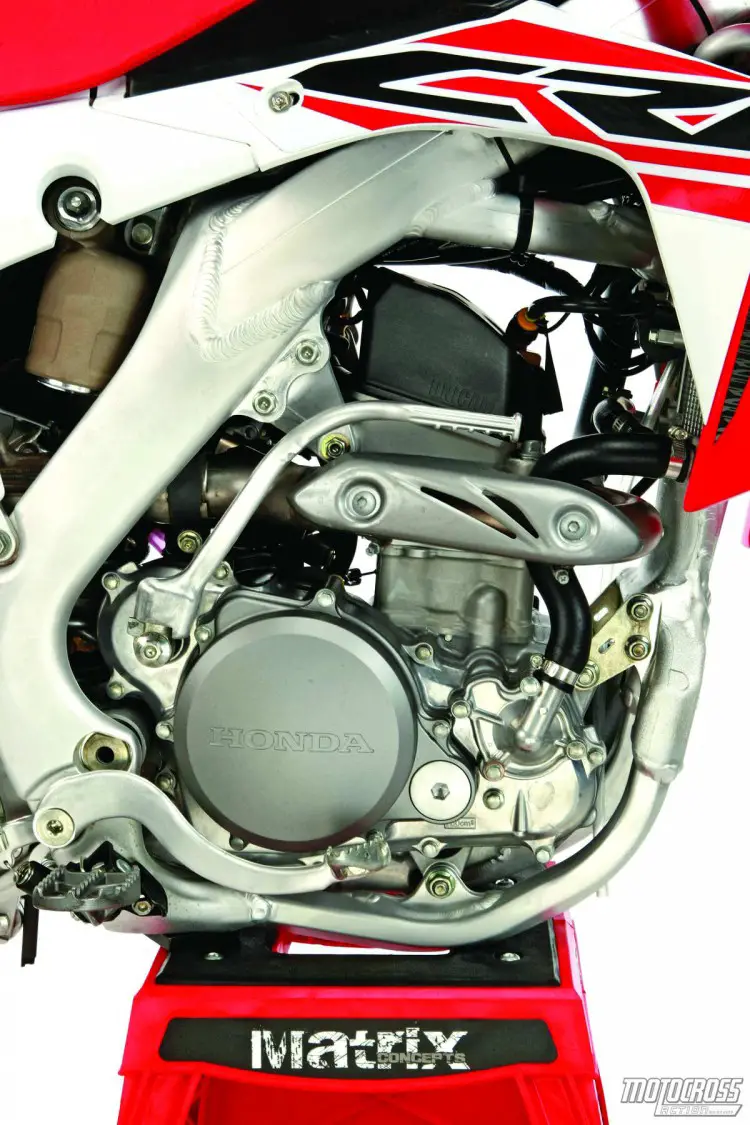
Q: HOW DO YOU CHOOSE BETWEEN THE THREE MAPS?
A: Obviously, Honda's Engine Mode Select (EMS) is just an easier-to-use version of Suzuki's and Kawasaki's plug-in couplers. Plus, the function is basically the same as Husqvarna's handlebar-mounted, two-position map switch, except with three maps. Here is a quick rundown on how to choose between the three CRF250 maps.
Map one. Known as the "stock" map, this setting works well on most track conditions. It does nothing exceptionally well.
Map two. Map two is designed to work best on hard-pack terrain. It is the "mellow" map. It retards the ignition to lessen wheelspin and detunes the engine. We are of the opinion that map two is useless. Why? The Honda CRF250 is already struggling to keep pace with the competition, and it's not too much of a stretch to say that Honda's stock powerband is comparable to the other brands' "mellow" maps. MXA testers loathed map number two.
Map three. Honda's third map was the unanimous choice for every MXA test rider—from Beginner to Pro. Map three should have been the stock map, and then Honda could have gone even more extreme on the advanced ignition timing option.

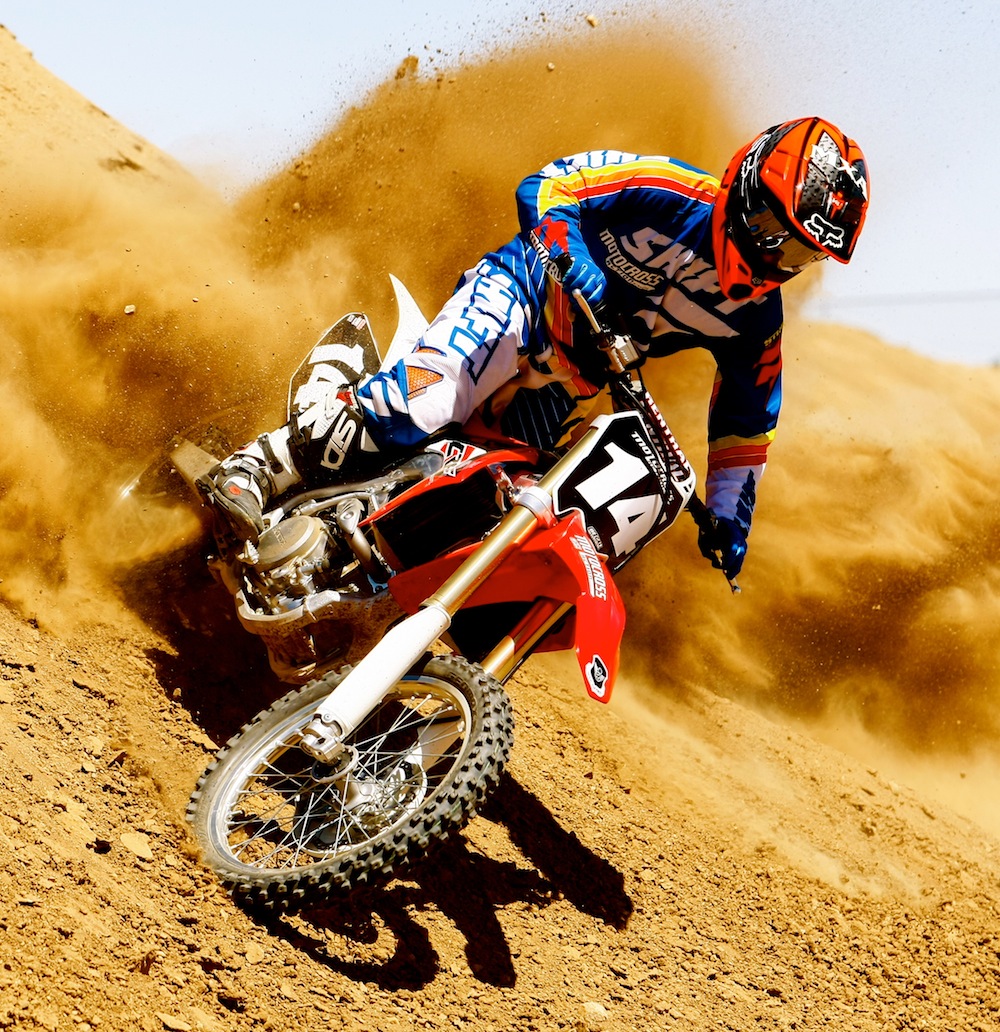
Q: WHAT ARE THE REDEEMING TRAITS OF THE 2015 HONDA CRF250?
A: The 2015 Honda CRF250 does several things very well, and it was popular with a broad range of test riders. That might sound confusing, given that the CRF250 is at its best in the hands of Beginners and Novices, but faster riders liked the feeling of being able to muscle the bike around without repercussions. And, once the suspension is balanced, the CRF250 can hit inside lines with ease. It still suffers from headshake at high speed or when the forks are unloaded, but in the right conditions it corners like a cheetah in pursuit of a rabbit.
The Showa SFF TAC forks deserve some kudos. In previous years we complained about the CRF250's soft spring rates and the forks' inability to hold up through rough terrain. The new air design far exceeds the conventional cartridge layout in nearly every way. The forks track well across a multitude of surfaces and have a suppler feel compared to last year's spring design, especially in the beginning of the stroke.
The only major quibble about the TAC forks is that the average rider will not fully understand the intricacies of setting and checking multiple air pressures before every ride. Having said that, the CRF250 has the second-best forks in the class. In our opinion the 2015 Yamaha YZ250F, with the tried-and-true Kayaba Speed Sensitive System fork, is best.
The CRF250's ergonomics are quite pleasing right off the showroom floor. The open cockpit, narrow frame, neutral Renthal 997 handlebars and flat seat profile were appreciated by every tester.
Q: HOW FAST IS THE 2015 HONDA CRF250?
A: We'll answer this question with a glass-half-full response. In stock trim, the CRF250 is very manageable, with a nice low-to-midrange transition. Throttle response is peppier than on last year's bike, thanks to a lighter throttle return spring. The CRF250 engine has the perfect entry-level powerband.
That is where the compliments end. Faster riders had a tendency to over-ride the engine to the point where they couldn't recover from mistakes. Top-end power is flat, while over-rev is minimal. Maximizing the CRF250 powerband requires an understanding that the engine cannot sustain a heavy load. The best approach is to keep the power in the midrange and shift before peak. Otherwise, you'll be going nowhere fast.

Q: HOW DOES THE 2015 HONDA CRF250 HANDLE?
A: There are times, such as on tight tracks with good traction, when the CRF250 shines. When the conditions are right, the CRF250 can hit tight lines easily; however, high-speed corners can be troublesome. It's a give-and-take situation at every turn. At times, the front end has a mind of its own, wandering, drifting or shaking like a dog in a rainstorm. That's why it's imperative to achieve chassis balance.
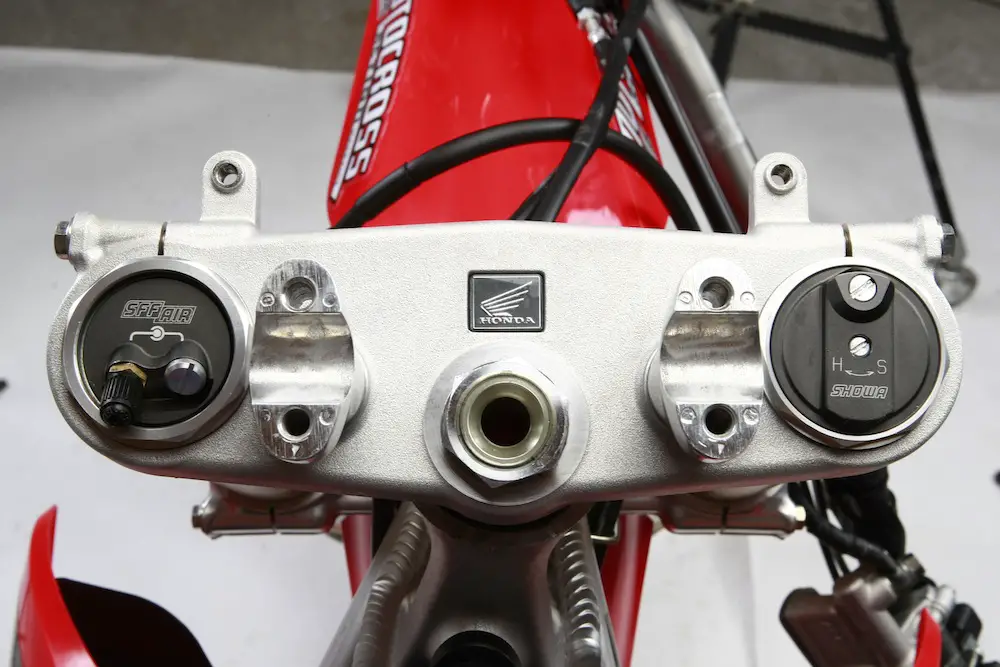
Q: WHAT WOULD WE DO TO IMPROVE THE 2015 HONDA CRF250?
A: Find satisfaction by making these key changes:
(1) Steering stem. We go in on the HPSD steering damper clicker, but don't be afraid to crank down on the steering stem nut also. Tighten it until excess slop is gone when applying light pressure to the bars.
(2) Mapping. We suggest trying the three maps in a variety of conditions. Our favorite is the aggressive setting (map three).
(3) Exhaust. Dropkick the dual exhaust for an aftermarket single. We've had very good results with the FMF, Pro Circuit and DR.D single-sided pipes.
(4) Clutch. The CRF250 clutch is soft and spongy, especially in the hands of a clutch abuser. We recommend installing stiffer aftermarket clutch springs on day one. The best all-around fix is a complete Hinson clutch.
![CRF2502015BERM]()
Q: WHAT DID WE HATE?
A: The hate list:
(1) Engine. The meek shall inherit the earth, but they won't have any trophies to show for it.
(2) Dual mufflers. At least they look cool.
(3) Headshake. On fast tracks we recommend wearing a St. Christopher medal.
(4) Frame cradle. Imagine a motorcycle that doesn't sit flat on a stand. The frame cradle is to blame.
(5) Side panels. It's tough enough to install preprinted numbers on a single number plate panel, but two? Good luck.
Q: WHAT DID WE LIKE?
A: The like list:
(1) Ergonomics. The CRF250 feels comfortable, regardless of your stature.
(2) Front brake. It's still not up to the KTM/Husqvarna pedigree, but the 260mm oversize front rotor has better bite than the old brake.
(3) Forks. The Showa SFF TAC forks aren't for everyone, but those who dial them in will be rewarded.
(4) Engine Mode Select. Options are always nice.
(5) Durability. The CRF250 takes a licking and keeps on ticking.
Q: WHAT DO WE REALLY THINK?
A: Honda's stated goal with the CRF250 was to make a motorcycle that wasn't too fast for the common man. Mission accomplished.
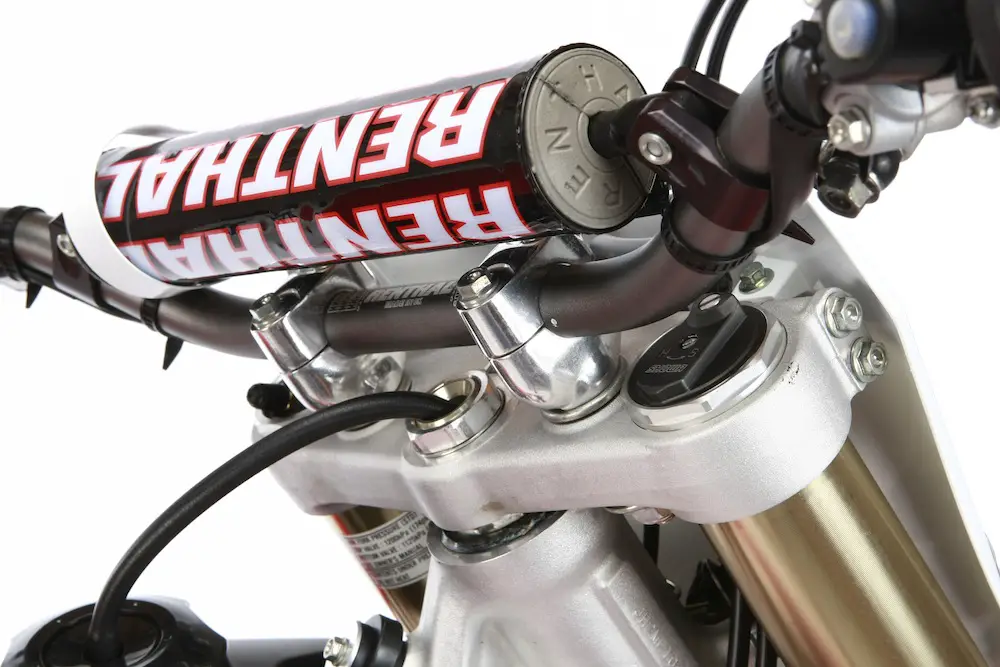
MXA HONDA CRF250 SETUP SPECS
Are you looking to get the 2015 Honda CRF250 suspension set up? Use these specs as a starting point and adjust accordingly.
SHOWA SFF TAC FORK SETTINGS
Gone are the 2014's conventional Showa cartridge forks; in their place are all-new Showa SFF TAC air forks. There are three air chambers, but only the inner and balance chamber are adjustable on the CRF250. Note that there is a valve opening to access the outer chamber, but it has been blocked off. Expect aftermarket companies to develop and sell a screw-in Schrader valve that allows air pressure changes in the outer chamber.
What's the benefit of adjusting the outer chamber? We've learned that the outer chamber can be used for bottoming control. Not having this w for heavier or faster riders; however, it's possible to achieve harmony with the SFF TAC fork. Follow these steps for CRF250 suspension bliss.
(1) Set the correct air pressure for your weight and riding style in the inner chamber. The inner chamber should be adjusted in small increments, while the balance chamber can be adjusted in even smaller increments. We added more pressure to the inner and balance chamber.
(2) Get the chassis balanced. The CRF250 has a stinkbug stance, with most of the weight directed toward the front end. It's best to alleviate weight on the forks by adding air to the inner chamber, lowering sag and adjusting fork height.
(3) Remember to use the compression and rebound fork adjusters. Don't get caught up in finding the perfect air pressure without also trying different clicker settings.
For hardcore racing, these are MXA's recommended 2015 Honda CRF250 fork settings (when changed, stock settings are in parentheses):
Inner chamber: 180 psi (174 psi)
Balance chamber: 170 psi (163 psi)
Oil quantity: 357cc
Compression: 9 clicks out (5 clicks out)
Rebound: 10 clicks out (12 clicks out)
HPSD: 7 clicks out (9 clicks out)
Fork-leg height: Flush with top clamp
Notes: The chambers are interrelated.
SHOWA PRO-LINK SHOCK SETTINGS
Here is what the MXA wrecking crew ran in its 2015 CRF250 (when changed, stock settings are in parentheses):
Spring rate: 5.3 kg/mm
Race sag: 104mm
Hi-compression: 3-1/4 turns out (3 turns out)
Lo-compression: 5 clicks out (10 clicks out)
Rebound: 6 clicks out (8 clicks out)
Notes: The shock is very sensitive to high-speed compression. Heavier riders should go in 1/4 turn on the high-speed compression and set the sag at 100mm.

Click here to subscribe to MXA: https://hi-torque.com/motocrossaction

Source: https://motocrossactionmag.com/2015-test-ride-honda-crf250/
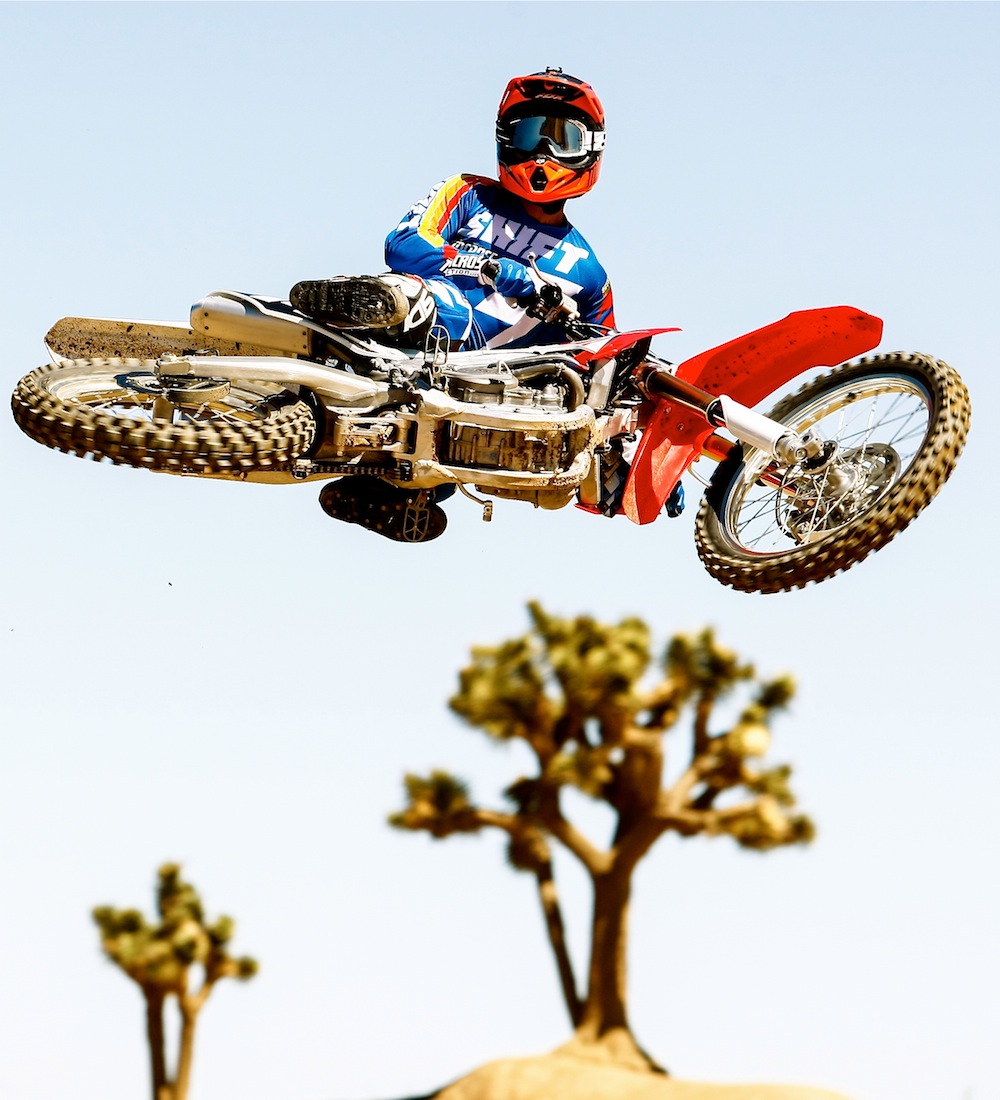 Q: FIRST AND FOREMOST, IS THE 2015 HONDA CRF250 BETTER THAN THE 2014 CRF250?
Q: FIRST AND FOREMOST, IS THE 2015 HONDA CRF250 BETTER THAN THE 2014 CRF250? 

Tidak ada komentar: